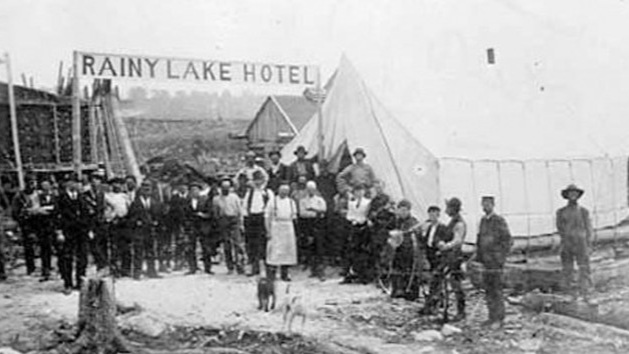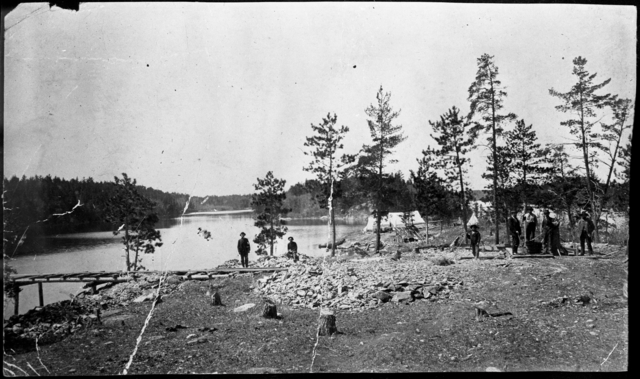Rainy Lake Gold Rush
When people think of the gold rush, they think of California, but Minnesota had its own gold rush. With stories of people striking it rich in California spreading east, even the slightest hint of gold elsewhere in the country would spark a new frenzy. When a vein of gold-laden quartz was found amid the forests and lakes of Minnesota – the hunt was on. While it certainly wasn’t as large or frenzied as California’s rush, Minnesota’s gold rush shaped the history of the northern-most part of the state.
In 1865, State Geologist Henry Eames encouraged assay on a vein of quartz from Lake Vermillion that had indicated a gold value of $23 per metric ton. He explained that the states around the lake were crisscrossed with veins of quartz in which nearly all showed the presence of precious metals like gold and silver.


After the results of the Eames assay had begun to spread, people started to flock to Lake Vermillion. A reporter with the St. Paul Pioneer Press wrote in 1865 that a majority of points on the lake were “composed of talcose slate sprinkled with gold-bearing quartzes.” He went on to explain that the rocks were covered with thick, spongy moss that when removed revealed bright veins of quartz enriched with gold.
Specimens valued near $165 per metric ton were being reported to St. Paul. Between 1865 and 1866 several gold mining companies sprung up in the state’s capital. Trainloads of supplies and machinery pressed north to Duluth where the goods were transferred onto a wagon for the overland journey to Lake Vermillion along a rutted, muddy road hacked out of the forest just weeks prior.
Enthusiastic speculators were kept busy until the first multiple-sample assay came back. As it turned out, the samples contained nearly no gold. They had found fool’s gold. By the summer of 1866, most of the miners had left the area poorer than when they arrived.
The Little American Mine
Some speculators weren’t as quick to give up on the idea of gold in the area. Small bands were found on the Canadian side of Lake of the Woods and along the north shore of Lake Superior. One of those speculators, George W. Davis, had made a fortune in gold on the Canadian side of Lake of the Woods. He believed that since there were gold deposits around Lake Vermillion and Lake of the Woods, there should surely be veins of rich gold around Rainy Lake. So, in July of 1893, Davis stopped at an island near the entrance of Black Bay on Rainy Lake. On the western side of the island, he found gold in a two-meter vein of quartz. Davis quickly purchased the mineral rights on the land, but because of the fools gold rush of 1865-1866, he was unable to obtain the financial backing he needed to begin a mining operation on the island.


Davis eventually sold the mineral rights to a group of Duluth businessmen. They began their mining operation, dubbed the Little American Mine, with a small crew in January 1894. They built a stamp mill to extract the gold from the quartz in nearby Rainy Lake City. By July, the mill was processing gold valued at $30 per ton. This success leads to an expansion of the mine by way of a 45-foot vertical shaft from which drifts were extended to extract the exposed minerals. A bunkhouse for the crew, shaft house, and headquarters building were constructed on the island around the same time. Loading facilities were also built along the south shore to speed up the transport of the quartz to the stamp mill. In nearby Rainy Lake City, a hotel, schoolhouse, newspaper office, and saloons were added. The gold from the island continued to assay at $30 per ton or more, but the mine was forced to close for a good portion of 1895 because of a lawsuit between the Duluth-based partners running the operation.
Over the next two years, new managers reopened and closed the mine twice. The first attempt to reopen the mine was cut short due to gold of lower quality than anticipated being pulled from the mine. The mine operated sporadically throughout the summer of 1896. In 1897, a small but steady profit was being made, and the Little American Mine was poised to reach its full potential. However, a short halt in production in December resulted in permanent closure for unknown reasons. Further attempts to reopen the Little American in 1901 and 1920 were unsuccessful.
Historic Legacy
The Little American Mine operated from 1893 to 1898. The average value of the gold extracted during that time was $30 per ton, which represented a profit of around $12 per ton. The Little American is the only gold mine in Minnesota known to have produced a profit. The impact of the mine was felt primarily in Rainy Lake City. After the mine closed, Rainy Lake City slowly disappeared and was considered a ghost town by 1901. Although the mine was productive, a large vein of rich gold was never found to kick off a gold rush to rival those in California. Oddly enough, the influence of the Little American Mine on the mining industry occurred in Canada, where the large veins of gold were finally found.
Today, Little American Island is located within Voyageurs National Park. Remnants of the mine can still be found under years of overgrown brush and pine trees. Two major excavations from the Little American Mine are still visible on the island: a vertical, cribbed shaft and an entrance to a horizontal shaft. Both are filled with debris and water. Other excavations are visible but appear to be the open pit of shallow depth. Park visitors can visit the abandoned island on boat tours that launch from the Rainy Lake visitors center.
References:
Rainy Lake Herald. 1897 Rainy Lake Journal. 1894, 1895, 1896, 1897
Winchell, N.H. The Geological and Natural History Survey of Minnesota, 23rd Annual Report. 1895.
